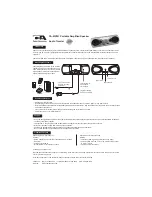
Chapter 2 — Functional Description
2-2 Major Subsystems
MG3702xA MM
PN: 10370-10372 Rev. B
2-5
The external ALC circuits have provisions for leveling with either an external crystal detector or power
meter. The output polarity of the detector or power meter may either be positive or negative.
Auxiliary Control (A4 PCB)
Pre10 and –10 volt references are created for the DVM, Ramp Generator, and Horizontal Output
circuits, all of which are generated by this PCB. The DVM circuit is used to monitor most systems in the
synthesizer.
Marker, sequential sync, retrace and band switch blanking signals are also created by the A4 and sent to
the rear panel Aux I/O connector.
RF Deck
The RF Deck subsystem shown in
contains those elements related to the generation,
modulation, and control of the sweep and CW-frequency RF signals. These elements include the:
•
A9 RF oscillator/coarse loop/fine loop PCB
•
Switched filter assembly
•
Down converter assembly (option 004)
•
Directional coupler/level detector
•
Optional step attenuator (option 002)
for a functional overview of the RF deck subsystem.
AC Power and DC Voltage Regulation
AC power for the synthesizer passes through a rear panel on/off switch and a line filter module before arriving
at the power supplies. See the block diagram in
. A main power supply and a separate
standby power supply provide several DC voltages to the A3 voltage regulation PCB.
The rear panel on/off switch provides complete disconnection from the AC power and should not be used for
normal power on/off purposes.
When the rear panel switch is set to the ON position, the standby power supply is always on regardless of the
state of the instrument. The standby supply provides constant power to the internal 100MHz oscillator, power
supply fan and the front panel switch, in addition to a control signal for the main power supply.
When the instrument is turned on using the front panel switch or at initial power on, the main power supply is
activated and produces outputs of +16.25V, -16.25V, +6.75V and +26V which is routed to the voltage regulator
board via a cable.
Voltage Regulation (A3 PCB)
The purpose of this PCB is to convert and regulate the coarse switching main and standby power supply
output voltages to the many precise voltages required by the various assemblies in the synthesizer.
shows the applications for the various output voltages. The regulation removes the power
supply ripple due to switching transients. The A3 PCB also converts the standby power supply voltage
(+13V) to +12V and +5V.
In addition to buffering the +16.25V, -16.25V, +6.75V, +13V and +26 volts from the main power supply,
there are 2 signals that are routed into and out of the A3 PCB:
•
PWRFAIL is the status line from the main power supply which provides a TTL “High” signal when
the AC input voltage is within the acceptable range.
•
PSINHIBIT is the control signal from the instrument front panel “ON/OFF” switch which is fed to
the main power supply to activate the power supply.
Note
Use of the rear panel switch instead of the front panel switch prevents important instrument functions
from being performed and can lead to Microsoft Windows XP operation errors.
Summary of Contents for MG3702xA Series
Page 4: ......
Page 5: ......
Page 8: ...TG 8 PN 10370 10372 Rev B MG3702xA MM ...
Page 24: ...1 12 Test Equipment List Chapter 1 General Information 1 10 PN 10370 10372 Rev B MG3702xA MM ...
Page 42: ...2 5 RF Deck Assemblies Chapter 2 Functional Description 2 18 PN 10370 10372 Rev B MG3702xA MM ...
Page 120: ...5 5 Troubleshooting Tables Chapter 5 Troubleshooting 5 24 PN 10370 10372 Rev B MG3702xA MM ...
Page 182: ...Index 4 PN 10370 10372 Rev B MG3702xA MM ...
Page 183: ......
















































